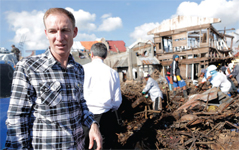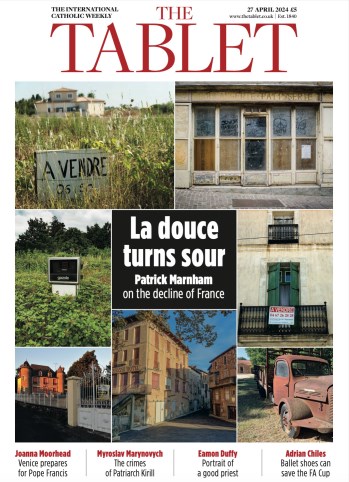Following a recent visit to communities shattered by last month’s typhoon in the Philippines, the shadow International Development Secretary argues that help must be long-term and is best delivered by those close to the ground, such as the Church in this Catholic country
Divided by less than 100 miles of land and sea, the cities of Cebu and Tacloban are, after the events of 8 November this year, worlds apart. Cebu remains a bustling tourist centre, apparently untouched by last month’s typhoon. Tacloban, however, is utterly devastated.
The day I arrived, three weeks after the world’s best non-governmental organisations and aid departments began working with local communities to put this city back together, there was no mistaking what had gone before. In truth, the scale of the destruction is impossible to explain properly.
The television pictures do no justice to the real scene on the ground in Tacloban. Haiyan was the strongest typhoon ever to make landfall. What I saw there will stay with me for the rest of my life. In every direction and as far as the eye can see there is utter, utter devastation.
I was in the Philippines as a guest of Cafod and its American sister agency, Catholic Relief Services (CRS). The dedication and determination of the young aid workers I met was striking, living out in the field and sleeping by night in the very evacuation centres they help staff by day.
Small houses were washed away, livelihoods destroyed, whole communities obliterated in the space of five or six hours. Even some of the most expensive and sturdiest buildings on the island of Leyte, right down to its newest place of worship, lost their roofs. Our visit to the now roofless cathedral brought a stark reminder that many suffered a far greater loss than bricks and mortar. The arrival of a small and dignified funeral procession brought our tour to an abrupt close.
Five thousand lives were lost in and around Tacloban alone. A single disturbed piece of turf in the town centre – no bigger than the penalty box on a football field – is now the site of a mass grave, where 1,000 lie buried. It is a terrifying number, but each an individual tragedy. And it is against this backdrop that the Church is such a rock for those left behind.
In a country where 70 per cent of the population are Catholic, the Church is a constant in the community. It is providing not just moral and spiritual support but material support as well. At the centre of terribly damaged communities, faith is holding neighbourhoods together. And these islands need all the help they can get.
Nature has made the Philippines one of the five most dangerous countries on earth. The country is recovering from four different natural disasters in the past year and the typhoon season is not over yet. But the Philippines holds a crucial advantage over many other countries that have suffered natural disasters in the last decade – the sheer capacity of its government and civil society, in part thanks to the firm structure of elected leaders taking charge of each barangay or small neighbourhood.
In the suburb of Camire, I saw the local leader work with Cafod and CRS to help organise a British-funded water sanitation and hygiene distribution centre, while in Cogon, the same partnership helped set up a “cash for work” programme, giving unemployed locals the opportunity to clear the debris from their streets in return for a government-prescribed minimum wage. Forty men cleared the debris to get through to the road. It is painstaking work, and even now 50 bodies a day are pulled from the rubble.
At times like this, it is vital that the local economy receives the boost it needs by getting local people back to work as quickly as possible. These schemes help communities in desperate need of jobs and money do just that. The influx of cash they provide helps get markets moving again to motor local communities back towards normality. Aid helps get that going but it is paid work that sustains it.
The men clearing rubble from the roadside talked not of the typhoon, but the tsunami – three storm surges followed in Haiyan’s wake. It was not the strength of the wind, but walls of water that caused so much devastation. These destroyed all before them, but it is what they left behind that could destroy livelihoods for years. When arable land is submerged by the sea, there is a real risk of salt making it unusable for crops. It is too early to tell how big a problem this will be, but with the planting season ending in January 2014 there is no time to waste.
That is not the only threat to farming. Once coconuts were a vital cash crop; now the whole island of Leyte is littered by dead and dying trees – beheaded and ripped apart by the storm. Each decaying tree represents a lost source of income, and there are many thousands of them.
Everywhere you look, there are more difficulties to overcome. What came across strongest throughout my time in Tacloban was the sheer complexity of the relief effort. Even with Government and local leadership as good as it is, the picture in the Philippines is impossibly complicated. The sheer number of agencies, governments, local leaders and charities would make coordination difficult at the best of times, but in a disaster zone it can feel almost impossible.
For example, at the United Nation’s makeshift office close to the airport, staff told me that it is vital we get the money in now to buy seeds so that local people who want to return to work and get on have something to plant in time for the harvest. The UN flash appeal has received hundreds of millions of dollars but donors are prioritising life-saving food parcels over the grain needed for a sustainable recovery. This is something that needs to be resolved, and time is an enemy – the rice seeds need to be planted within weeks if the crop is to reach maturity next year.
The question of seeds or food speaks to a wider tension: the balance of emergency relief against building sustainably for a future without aid. Obviously people need short-term relief, but we cannot lose sight of an opportunity to improve resilience for the long term. There is little point in spending money on rebuilding the same wooden shacks in the same places.
Britain’s Labour Party has always said that at least a tenth of the aid we donate for disaster relief should be pointed towards future disasters – “building back better”, in the jargon of humanitarian aid. On this occasion, the UK Government has committed £5 million long-term aid out of its total post-typhoon package for the Philippines of £60m, but I’d like to see it make a commitment to follow Labour’s lead and commit to 10 per cent every time.
No discussion about long-term solutions is complete without climate change. As an international community, we have to do more. It would be wrong to ascribe any particular weather event to the dangers of climate change, but the ever-growing pattern of extreme weather is undeniable.
Part of the solution is about trying to halt the pace of climate change, but it is also about dealing with the reality of greater risk. That means better warning systems and stronger shelters. When Haiyan hit, people did not head for the hills: they fled to sturdy buildings. In lots of places, that was exactly the right thing to do, but in others it left them in harm’s way. Early warning systems are vital but they have to be comprehensible. The sad truth is that many heard warning of a storm surge but did not know what it meant.
But among the hurt there is hope. In the town of Tanauan, where 2,000 people died, we heard the story of a newborn baby, born amid the carnage, and of how the father, trying to flee the rising water, saved his infant from the waves by locking the child in a watertight fridge. It was a horrific thing to have to do but both survived.
Make no mistake, Tacloban is a scene of genuine devastation, but it is also a city determined to come together and try to rebuild. One clear fact stands out above all from my visit to the Philippines. Aid works, aid saves lives; it protects the vulnerable and gets communities back on their feet. It comes from governments and from donors but it is more successful if it is delivered by organisations that live in the communities affected, and in the Philippines almost no one is closer than the Catholic Church.
* Jim Murphy MP is the shadow Secretary of State for International Development. To donate to the Philippines Typhoon Haiyan Appeal visit www.cafod.org.uk





 Loading ...
Loading ...
What do you think?
You can post as a subscriber user...
User Comments (0)